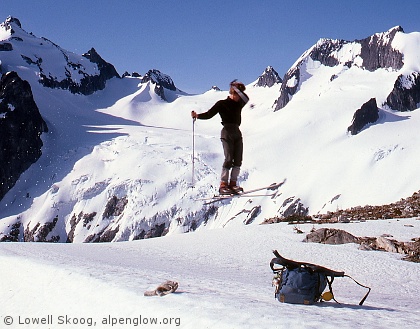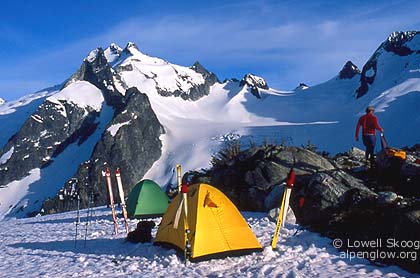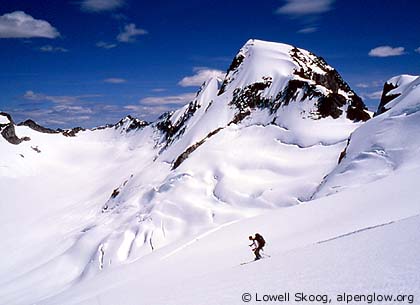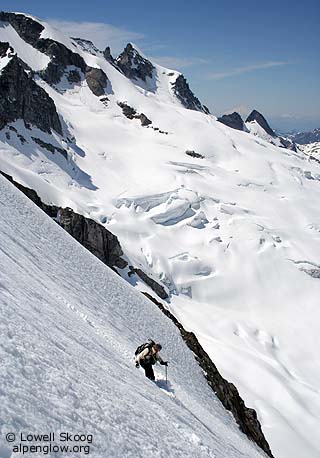

|
| Dome Peak and its Chickamin Glacier dominate the Cascade Crest at sunrise, May 1997. (Map, 600kb) |
|
"Oh my gosh! What is that?" Resting on their skis above Sibley Pass, near the heart of the North Cascades, Walt Hoffman and partner Dwight Watson gaped at a panorama never before seen by skiers.
It was May 1937. Hoffman, fresh from a winter in the Alps, had accepted the invitation of his friend Watson to scout the little known area on skis. Watson, one of the few climbers to have explored these mountains, replied, "Why, that is just the crest of the Cascades. Why do you ask?" "I just thought I was back in the Alps," said Hoffman. They later wrote, "A hundred peaks uplifted in the nearer vicinity, and the valley of the Skagit lay with its emerald green beauty. Most thrilling of all was the Cascade Crest region south of Cascade Pass where the white of winter is lost amid the wild confusion of pinnacles deep etched and forbidding." In 1937, the North Cascade crest between Cascade Pass and Dome Peak was largely unknown. A few climbers, including Watson, had ventured into the region at points along the divide, but the crest as a whole was almost completely unexplored. A year later, at the height of the Depression, four former Boy Scouts from an obscure Seattle group called the Ptarmigan Climbing Club traversed the entire crest on foot, climbing all the major summits along the way. The achievement of Calder Bressler, Ray Clough, Bill Cox, and Tom Myers went undocumented for twenty years, but it passed into campfire legend. The Ptarmigan Traverse had been born. Fifteen years passed before the route was again traveled in its entirety. In 1953, the area was still so mysterious that the second Traverse party, including photographer Tom Miller, dubbed themselves the "What is South of Cascade Pass Anyway?" expedition. As others followed, the veils of mystery were removed and the route came to be regarded as a Northwest classic. Still, forty years passed between that first glimpse by pioneer skiers Watson and Hoffman and serious attempts to actually ski the traverse.
Credit for the idea of skiing the Ptarmigan goes to Bill Nicolai. He had done the traverse on foot and told his friend Steve Barnett it would be a perfect trip for skis. The pair set out in May 1977. They camped above Cascade Pass and spent the afternoon and following day watching avalanches rumble off the walls of Mixup Peak, sweep the slope they hoped to cross, and thunder over the cliffs into Pelton Basin below. Discretion won out and they retreated with hopes of returning another day. A year later, Barnett and two friends tried the traverse in mid-June. The forecast wasn't perfect, but no major storms were expected either. Unfortunately, they found that along the Ptarmigan Traverse, so-so weather can mean no-go weather. Pinned down by fog and drizzle for days mid-route, they ran out of food and finally bailed out, navigating across the South Cascade Glacier by altimeter and compass, then stumbling along a very rudimentary trail to the Cascade River road. As Barnett later wrote, "The ten rainy miles out on this trail are not remembered with a warm glow." Inspired by a Barnett slide show, Brian Sullivan, Dan Stage and Dick Easter set out to ski the Ptarmigan in June 1981. In three days they traversed from Cascade Pass to White Rock Lakes, making several skiing and peak bagging side-trips along the way. Foul weather on the fourth day kept them cooped up in their tents, tiny one-man jobs that Sullivan dubbed "squeeze tubes." Determined to make their escape on the fifth day, they navigated in fog over Spire Col, dropped to Cub Lake, and thrashed their way out Bachelor and Downey Creeks, arriving at the Suiattle River road after dark and soaked to the bone.
The following June, I made the second ski crossing of the route with three friends. Mark Hutson had been in Steve Barnett's party in 1978, and realized that moving quickly would give us the best chance of avoiding fog and rain. Our strategy was rewarded with three days of perfect weather. It was my first real ski traverse, my first time along the Ptarmigan, and something inside me resonated with the experience. I recall scrambling up the summits of Le Conte, Sentinel Peak, and Old Guard on day two, and still having enough energy to make a ski run with Mark down the South Cascade Glacier at sunset. I remember finding a little windsculpted ridge next to White Rock Lakes on the third morning. I yielded to the urge to drop my pack, sidestepped up the hill, swooped down and threw a helicopter off the jump in my climbing boots and Ramer bindings. The photographers in the group were caught off-guard the first time, so I climbed back up and did it twice more. But most important, I remember the feeling of untouched wilderness and the sense of flowing through it on skis. There were no tracks, no fire rings, no trampled meadows, nothing to dispel the illusion that we were the first people ever to set foot or ski in this country. I skied other high routes in the Cascades and Olympics in the years that followed, but the Ptarmigan Traverse continued to draw me back. In 1986, my wife Stephanie, another friend and I spent a leisurely week in summer walking the route, bagging all the peaks I'd missed on my faster-paced ski trip. In June 1988, I pushed the pendulum the other way, skiing the route with my brother Carl in a single headlamp-to-headlamp day. Still, the Ptarmigan wasn't finished with me. I read about the adventures of the third traverse party, led by photographer Ira Spring in 1957. The third party had extended the route past Dome Peak, over the Chickamin Glacier, along the Hanging Gardens to Totem Pass, and then to Image Lake and the Suiattle River. North Cascades author Harvey Manning has called this "the most fully classic version of the classic" adding, "no version that omits Dome can be considered 'the' Traverse."
Manning's words haunted me. I'd skipped Dome Peak both times on skis, though I'd climbed it on foot with Steph. Returning in June 1982, just a couple weeks after my first trip, Steve Barnett and partners had skied Dome Peak, probably the first party to do so. The idea of making Dome the centerpiece of a longer trip appealed to me, and I daydreamed about the mysterious Hanging Gardens, first visited by Dwight Watson and Hermann Ulrichs in 1936. Finally, I imagined putting a little "ptwist" at the end of the Ptarmigan, by ending the trip at Holden Village near Lake Chelan, thus combining a crest route with a west-to-east crossing of the range (see map, 600kb). I was hooked. However, between other ski projects, working too much, having a son, and other good excuses, twelve years went by before I would return. In June 2000, I lined up Bruce Goodson from Seattle and Matt Firth from Twisp to give the extended route a try. We seized what looked like a good weather window, crossing our fingers that it would hold. As we climbed into the clouds at Cache Col on our first day, I pondered whether we'd jumped the gun. Under dreary skies, Bruce, Matt, and I made our way to Spider-Formidable Col and camped with muted enthusiasm. But as the clouds dissipated overnight, so did our doubts. We awoke to brilliant alpenglow on Sentinel Peak and the LeConte Glacier, the radiance of the snowfields emphasized by an outline of black rock spires.
As we skimmed along a contour toward Yang Yang Lakes on the second morning, I reveled in the feeling of flow that is unique to a ski traverse. Beyond the lakes, we booted up a steep snow finger and traversed to Le Conte Glacier. Here we dropped our packs and scrambled up Sentinel Peak, the best viewpoint on the entire route. The view from Sentinel is dominated by Dome Peak and its Chickamin Glacier, a magnet for any ski mountaineer. The first attempt to ski the Chickamin was in May 1948, when Charles Hessey of Yakima tried to reach it from Agnes Creek after a spending nearly a month skiing by himself near Lyman Lake. Hessey had the bad luck of making his attempt just as one of the worst spring floods in Northwest history began. It was perhaps fortunate that he was turned back by high water in Agnes Creek. Had he made it to the upper slopes, the avalanche danger would have been extreme. Hessey's adventure was years ahead of its time. Even fifty years later, I'd never heard of anyone skiing the Chickamin Glacier. We camped at White Rock Lakes and skied over Dana-Dome col the next morning. I'd hoped to camp near the summit of Dome Peak and enjoy skiing unencumbered down the glaciers on either side. But when we checked the weatheradio we learned that our fine weather window was about to close. Clouds and drizzle were expected the next morning. The summit of Dome was about the worst place we could think of to camp in those conditions. We could bail out from there toward Downey Creek, but if we wanted to complete the extended traverse, we'd better put some more miles behind us.
My plan of savoring the Chickamin Glacier on morning corn snow was foiled. During our afternoon descent, the glacier was thick gumbo. The setting was grand though. The scale of the glacier resembled the Alps or B.C. Coast Mountains more than our humble North Cascades. At Gunsight-Sinister col, we looked down a 45 degree slope several hundred feet high. I ski-cut the slope at its top, expecting to start a slough that would dissipate on the gentler slopes below. Instead it gained speed and volume, thundering out of sight into Spruce Creek valley. We skied down the newly cleared path, traversed west, and descended to the Hanging Gardens. I'd imagined for many years what the Hanging Gardens might be like and was not disappointed. The gardens are a series of granite bluffs and terraces adorned with krummholz and lush mats of heather. After the snow disappears in summer, the area abounds with charming lakelets and floral displays. I was sorry we didn't have more time to enjoy them. We camped near Ross Pass on a lovely, still evening, then watched clouds amass in the west. Rain pattered on our tents in the morning; we slept in. It was satisfying to know that we had acted on an accurate forecast, even though it had meant abandoning some of our goals. After pushing farther than we'd planned the day before, rest was welcome. By mid-afternoon the sky lightened, so we broke camp and hustled over Totem Pass and around Canyon Creek to Image Lake. We arrived just before sunset, and just as the clouds began to spit again. As it was, we squinted into wind-driven sleet while traversing Miners Ridge to Suiattle Pass on the fifth day. The weather gradually improved as we went, though, and by the time we reached Cloudy Pass, patches of blue were opening over Lyman Lake and Dumbell Mountain. On our left we could see the alp slopes of North Star Mountain. I thought of Dwight Watson and friends skiing it in 1938, over sixty years earlier. We removed our skis for the last time below Lyman Lake, and hiked down Railroad Creek to Holden Village in early evening. When we talk about classic routes, we often speak of their physical attributes--the scenery, the route finding, the quality of rock or snow. The Ptarmigan Traverse has all of these, but its stature as a classic is equally due to the people who pioneered it. As we cruised down Lake Chelan on the Lady of the Lake ferry the next afternoon, I thought of those people who had made the traverse what it is--the Ptarmigan Climbing Club and the others on foot; Watson, Hessey, Barnett and the rest on skis. Each had discovered new ways to experience this route. The traverse has now lured me across its glaciers and up its peaks four times. Yet, this latest trip suggests that even more new possibilities await the imaginative ski mountaineer. Perhaps, I'll be lured back yet again.
This article was published in the Spring 2001 issue of Off-Piste magazine. In May, 2005, I returned to the Chickamin Glacier with my brother Carl and three others to complete the first ski descent of the North Face of Sinister Peak. This trip was especially satisfying for Carl, since he participated in the first ascent of the route almost 26 years earlier. It was my last mountain trip with him, as he died in a ski mountaineering accident five months later.
--Lowell Skoog
|
||||||||||||||||||||||||||||||||||||||||||||||||||||
|
Previous | Next | Overview - Skiing the Cascade Crest | The Alpenglow Gallery |






